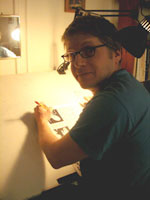
Comics are a medium used to express ideas with images, often combined with text or other visual information. It typically takes the form of a sequence of panels of images. Textual devices such as speech balloons, captions, and onomatopoeia can indicate dialogue, narration, sound effects, or other information. There is no consensus among theorists and historians on a definition of comics; some emphasize the combination of images and text, some sequentiality or other image relations, and others historical aspects such as mass reproduction or the use of recurring characters. Cartooning and other forms of illustration are the most common means of image-making in comics. Photo comics is a form that uses photographic images. Common forms include comic strips, editorial and gag cartoons, and comic books. Since the late 20th century, bound volumes such as graphic novels, comic albums, and tankōbon have become increasingly common, along with webcomics as well as scientific/medical comics.

Harvey Kurtzman was an American cartoonist and editor. His best-known work includes writing and editing the parodic comic book Mad from 1952 until 1956, and writing the Little Annie Fanny strips in Playboy from 1962 until 1988. His work is noted for its satire and parody of popular culture, social critique, and attention to detail. Kurtzman's working method has been likened to that of an auteur, and he expected those who illustrated his stories to follow his layouts strictly.
Justin Considine Green was an American cartoonist who is known as the "father of autobiographical comics." A key figure and pioneer in the 1970s generation of underground comics artists, he is best known for his 1972 comic book Binky Brown Meets the Holy Virgin Mary.

Jessica Abel is an American comic book writer and artist, known as the creator of such works as Life Sucks, Drawing Words & Writing Pictures, Soundtrack, La Perdida, Mirror, Window, Radio: An Illustrated Guide, and the omnibus series Artbabe.

Kitchen Sink Press was a comic book publishing company founded by Denis Kitchen in 1970. Kitchen Sink Press was a pioneering publisher of underground comics, and was also responsible for numerous republications of classic comic strips in hardcover and softcover volumes. One of their best-known products was the first full reprint of Will Eisner's The Spirit—first in magazine format, then in standard comic book format. The company closed in 1999.

Irving Samuel Kweskin, who sometimes worked under the name Irv Wesley, was an American advertising and comic-book artist.
TwoMorrows Publishing is a publisher of magazines about comic books, founded in 1994 by John and Pam Morrow out of their small advertising agency in Raleigh, North Carolina, United States. Its products also include books and DVDs.
Notable events of 2006 in comics.

Thomas Martin Spurgeon was an American writer, historian, critic, and editor in the field of comics, notable for his five-year run as editor of The Comics Journal and his blog The Comics Reporter.

James Romberger is an American artist known for his depictions of New York City's Lower East Side.
Highwater Books was an independent comic book publisher based in Somerville, Massachusetts. Highwater began in 1997 and folded in November 2004 due to financial pressure.

Josh Neufeld is an alternative cartoonist known for his comics journalism work on subjects like graphic medicine, equity, and technology; as well as his collaborations with writers like Harvey Pekar and Brooke Gladstone. He is the writer/artist of A.D.: New Orleans After the Deluge, and the illustrator of The Influencing Machine: Brooke Gladstone on the Media.
Brian Bram, raised in Deerfield, Illinois, played a minor role in the underground comix movement with his contributions to American Splendor, the comic book series written and published by Harvey Pekar and, more recently, with his work with author Jonathan Baylis on his autobiographical comic series, So...Buttons.
The Words & Pictures Museum of Fine Sequential Art was an art museum in Northampton, Massachusetts, devoted to exhibitions of narrative art, cartoons, comic books, and graphic novels. Open to the public from 1992 to 1999, the museum's collection at one point numbered 20,000 original works from hundreds of artists including Simon Bisley, Vaughn Bodē, Robert Crumb, Richard Corben, Frank Frazetta, Jaime Hernandez, Jack Kirby, George Pratt, Dave McKean, Frank Miller, Jon J Muth, Bill Sienkiewicz, and Gilbert Shelton.

Nick Abadzis is a British comic book writer and artist.
Mervyn "Skip" Williamson was an American underground cartoonist and central figure in the underground comix movement. Williamson's art was published in the National Lampoon, High Times, the Realist, the Industrial Worker, the Chicago Seed, Encyclopædia Britannica and others. His best-known character is Snappy Sammy Smoot.
Comics studies is an academic field that focuses on comics and sequential art. Although comics and graphic novels have been generally dismissed as less relevant pop culture texts, scholars in fields such as semiotics, aesthetics, sociology, composition studies and cultural studies are now re-considering comics and graphic novels as complex texts deserving of serious scholarly study.

Comics journalism is a form of journalism that covers news or nonfiction events using the framework of comics, a combination of words and drawn images. Typically, sources are actual people featured in each story, and word balloons are actual quotes. The term "comics journalism" was coined by one of its most notable practitioners, Joe Sacco. Other terms for the practice include "graphic journalism," "comic strip journalism", "cartoon journalism", "cartoon reporting", "comics reportage", "journalistic comics", "sequential reportage," and "sketchbook reports".
The history of American comics began in the 19th century in mass print media, in the era of sensationalist journalism, where newspaper comics served as further entertainment for mass readership. In the 20th century, comics became an autonomous art medium and an integral part of American culture.
Turtel Onli is an American artist, entrepreneur, author, art therapist, educator, and publisher.









